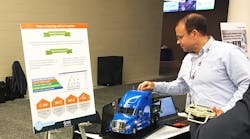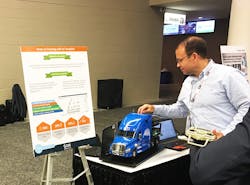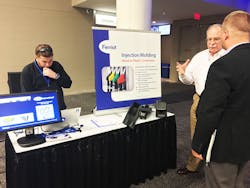The Industrial Design & Engineering show floor in Cleveland May 8-10 featured over 80 companies, each presenting a product or service designed to make industry run more smoothly. In the show’s Case Study Corner, five companies displayed exactly how their offerings helped customers achieve their goals.
Cobots with the Assist
Universal Robots (Odense, Denmark) highlighted a particular case study on how it helped Task Force Tips, a manufacturer of firefighting equipment, improve the process by introducing a collaborative robot. Task Force Tips already had integrated robots with machine tools as far back as 1990. The robots were hard-installed into specific machines and could not be relocated to other plant locations. They wanted to promote and maximize their personnel tending machining cells into more complex tasks while keeping spindle time up and consistent product quality. The CEO of Task Force Tips, Stewart McMillan, decided to find an answer by looking into collaborative robots. “We had heard of collaborative robots that could be used in a much more flexible manner, so we decided to explore this new technology,” said Stewart.
The solution supplied by Universal Robots was to deploy two UR10 and two UR5 robots into the factory. One UR5 cobot was mounted to a table on wheels and the other cobots were installed to tend the CNC machines. McMillan states that the “major impediment in the past to using robots was the security fencing required around the machine… UR Robots don’t need all that guarding. We can roll the table with robot right up to the machine.” The cobots are able to be programmed in a matter of minutes and the interaction between the robot and operator is very fluid. Task Force Tips were able to reduce the required operators per line from seven to three, and they are also able to run the robot for 21 hours unassisted. In a matter of 34 days, the savings generated justified the purchasing costs of the robot.
Expecting the Unexpected
SAS (Cary, N.C.) worked with a global heavy-duty truck maker to predict breakdowns before they occur. The truck manufacturer wanted to provide fleet customers a tool that would eliminate their unplanned downtime.
SAS collected diagnostic trouble code data logged when computers on board the trucks registered excursions from the normal operating range. Combining this data with insights from automotive experts, SAS developed analytic models which they were able to connect to real-time data.
The resulting system can create an alert when the precursors to an adverse event are recorded. Fleet managers report they now have up to 30 days advance notice of likely failures, leading to 30% greater uptime and 50% lower maintenance costs.
SAS displayed a miniature semi-truck, complete with rolling wheels, to demonstrate its real-time data logging and onboard data analytics capabilities. SAS-developed onboard analytics improved fleet uptime and cut maintenance costs by giving advance warning of impending breakdowns.
Digitizing Documentation
Digabit (Englewood, Colo.) showcased how its Documoto system helped Atlas Copco Construction (Stockholm) modernize parts listing and ordering. ACC’s worldwide construction equipment business fuels an annual revenue from parts and supplies on the order of $100 million.
However, ACC’s customers frequently ordered the wrong parts or were unaware of improved parts because they were using outdated paper catalogs. ACC’s administrative staff was spending significant time correcting orders for outdated parts and undertaking the time-consuming process of updating, double-checking, printing, and disseminating updated part catalogs.
ACC asked Digabit to digitize its parts catalogs into a form that let users search for their parts and access relevant inventory and technical information. Digabit implemented its Documoto relational database, including a cloud library, with an interface that permits quick search and online ordering.
Since implementing the new system, ACC has seen online part sales jump by 64%, bumping online orders from 25% to 41% of all orders. At the same time, this revenue stream has grown 4% and order-processing time has been cut in half, partly due to lower error rates. ACC also reports Documoto helps it track and report customer activity including user accounts, volume of user logins, and user activity on ACC’s Parts Online portal.
Cloud-Based CAD
Onshape (Cambridge, Mass.) 3D CAD software has been part of multiple companies’ stories. Onshape’s cloud-based software permits real-time collaboration among many users and is available for mobile Apple and Android platforms. NAFCO International of Fond du Lac, Wis., uses Onshape to design sheet metal frames for its lighting installations, often updating dimensions and design details on the mobile platform at customers' sites.
Racing outfit Perrinn Limited, Yorkshire, UK, is using Onshape to share its 2017 F1 car design with the public. Onshape lets racing fans view the design as it iterates in real time while letting Perrinn limit change permissions to design experts. Perrinn also uses Onshape’s branching and merging tools to let designers propose changes, then merge them with the master model or roll them back if they don’t prove out.
Onshape had computer aided design (CAD) models running at the ID&E Case Study Corner, displaying how cloud-based software provides collaborative CAD solutions. Meanwhile, Ferriot provided case studies on how resin components solved suppliers problems where metal components had failed.
Plastic for Pumps
Ferriot (Akron, Ohio) converted gas-nozzle boots from single metal stampings to fully assembled themoplastic parts for a fuel pump OEM. The boots receive and retain the nozzles when they are not in use.
Ferriot’s engineers chose resins that could withstand the harsh conditions around a gas pump: seasonal weather and temperature extremes as well as the presence of exhaust fumes and hydrocarbon vapors. The company also developed the part molds and designed and implemented production and assembly processes.
The new parts cost less and last longer than their metal predecessors. Ferriot is continuing to work with the OEM to transition from metal to plastic on other fuel-pump parts like the nozzle surround for which they are developing a paintable foam solution.



